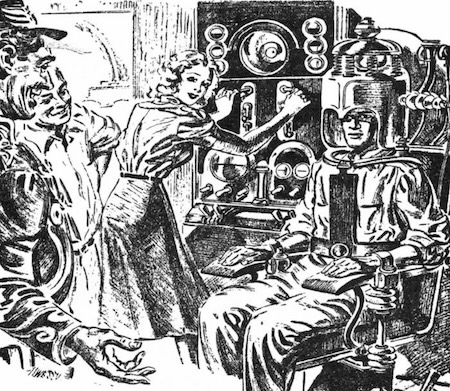Science Fiction
Dictionary
A B C D E F G H I J K L M N O P Q R S T U V W X Y Z
Latest By
Category:
Armor
Artificial
Intelligence
Biology
Clothing
Communication
Computers
Culture
Data Storage
Displays
Engineering
Entertainment
Food
Input Devices
Lifestyle
Living Space
Manufacturing
Material
Media
Medical
Miscellaneous
Robotics
Security
Space Tech
Spacecraft
Surveillance
Transportation
Travel
Vehicle
Virtual
Person
Warfare
Weapon
Work
"I am first of all not a science fiction writer … I write, I suppose, what the Latin Americans call magic realism."
- Harlan Ellison
| Ideophore | ||
| A device that quickly and (almost?) painlessly transfers knowledge from one brain to another. |
| KNOWLEDGE and memory, as Pat has proved, are really matters of bipolar moment and intramolecular potential, within the neurone cells. Her brain-ray pick-up scans that electrical pattern of knowledge, very much as the electron beam scans the photo-electric image in an iconoscope. The process, of course, is far more delicate and complex. But knowledge is converted, in essentially the same way, into electrical impulses.
“Those impulses can be transmitted through a special coaxial cable. They can be amplified, with special electron tubes. And, finally, through a phenomenon that Pat calls neuro-resonance, they can set up new bipolar moments and intra-molecular potentials, in another brain. “The ideophore, that is, can pick up knowledge from one brain, and transfer it almost instantly to another. There is a delicate system of tuning, which, with the cooperation of the teacher, makes it possible to select the subject to be taught.” ...Reluctantly, Cartwright climbed into the massive chair. There were padded straps for his wrists and ankles. “For your own protection,” Pat said sweetly. “There is an involuntary spastic muscular reaction.” The alarming helmet was lowered over his head. Captain Drumm stood behind the chair, with his head between two polished metal plates. Pat took her place at the intricate controls on the wheeled cabinet. Motor-converters hummed, and then a keen ominous whine stabbed into Cartwright’s brain. “Ready,” said Pat. “Five seconds of mathematics, and the theory and practise of astrogation. Now!”
 (Ideophore from 'The Fortress of Utopia' by Jack Williamson) Cartwright heard the switch click — and then his world was shattered under an avalanche of agony. A million searing needles probed into his brain. Intolerable flame blinded him. Thunder bellowed in his ears. He tried to count the eternal seconds. One. And two. But he felt as if the torture had already lasted minutes, hours. His awareness was flung away on a hurricane of flame. He was blanked out. Then it was over. Galt helped lift the helmet, free his bruised, aching wrists and ankles. Sweat drenched him. He relaxed in the big chair, panting... A few hours later, when he stood beside Captain Drumm at the curved control-board of the Pioneer, he was a little surprised to find that he knew the exact function of every dial and wheel and lever. |
| Technovelgy from The Fortress of Utopia,
by Jack Williamson. Published by Startling Stories in 1939 Additional resources -
|
Compare to the learning cap from The Knowledge Machine (1948) by Edmond Hamilton and accelerated schooling helmet from James Blish's 1957 novel Cities in Flight.
Comment/Join this discussion ( 0 ) | RSS/XML | Blog This |
Additional
resources:
More Ideas
and Technology from The Fortress of Utopia
More Ideas
and Technology by Jack Williamson
Tech news articles related to The Fortress of Utopia
Tech news articles related to works by Jack Williamson
| Liuzhi Process Now In Use In China |
| Animated Tumblebugs On Astounding Cover! |
| Has Elon Musk Given Up On Mars? |
| 'They Erased My Memory' Says Ariana Grande |
Want to Contribute an
Item?
It's easy:
Get the name of the item, a
quote, the book's name and the author's name, and Add
it here.
| <Previous | Next> |
|
|
|
Technovelgy (that's tech-novel-gee!) is devoted to the creative science inventions and ideas of sf authors. Look for the Invention Category that interests you, the Glossary, the Science Fiction Invention Timeline, or see what's New.
|
Science Fiction
Timeline
1600-1899
1900-1939
1940's 1950's
1960's 1970's
1980's 1990's
2000's 2010's
'If you're one of those rarities who haven't attended a rocket-polo "carnage", let me tell you it's a colorful affair.'
'They filed clumsily into the battleroom, like children in a swimming pool for the first time, clinging to the handholds along the side.'
'a walking balloon proceeded with long strides of its aluminum legs...'
'There was nowhere on the planet where science and technology could not provide one with a comfortable home...'
'Most men updated their PIP on New Year's Day...'
'...a misshapen, many-tentacled thing about twice the size of a man.'
